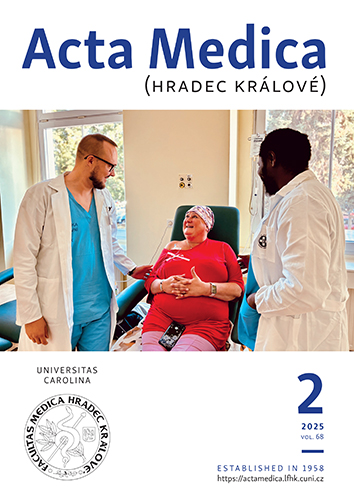ACTA MEDICA, Vol 64 No 2 (2021), 77–84
Innervation Patterns of the Pronator Teres Muscle and Their Possible Role in Neurotization: A Systematic Review of Cadaveric Studies
Bhagath Kumar Potu, M. V. Ravishankar
DOI: https://doi.org/10.14712/18059694.2021.14
zveřejněno: 02. 08. 2021
Abstract
Background: Contrary to the classic anatomical description, many recent studies have reported wide variations in branching patterns and location of motor branches that are supplying the pronator teres muscle. To understand these variations and their implications in surgical procedures of the nerve transfers, a systematic review was performed on the innervation of pronator teres muscle from cadaveric studies.Methods: A systematic literature search was performed in databases such as Medline, PubMed, Google Scholar, SciELO, ScienceDirect, Cochrane reviews and orthopedics textbooks using the search terms “pronator teres nerve branches”; AND “number” OR “location” OR “length” OR “diameter” yielded 545 article links. Articles were evaluated according to PRISMA guidelines. Results: A total of twenty cadaveric studies including 648 branches have registered 52.9% of two branch innervation pattern followed by 31.3%-single branch pattern; 13.5%-three branch pattern; 1.7%-four branch pattern, and 0.4%-five branch patterns, respectively. Of the 403 branches studied for their location in relation with the humeral intercondylar line, most branches were located distal to the line (50.3%), followed by 32.7% (proximal to it) and 16.8% at the line, respectively. The distance of branches located proximal and distal to humeral intercondylar line was in the range of 1.25–10 cm, and 1.1–7.5 cm, respectively. The mean length and diameter of nerves reported were 4.37 ± 2.43 cm, and 1.5 mm, respectively. Conclusions: Our data defined the morphometrics of nerve branches and they often met the required diameter for neurotization procedures. Our findings also demonstrated that the morphometrics, branching pattern and their location vary between populations and this information is very vital for surgeons during the nerve transfers.
klíčová slova: pronator teres; innervation; morphometrics; neurotization

Innervation Patterns of the Pronator Teres Muscle and Their Possible Role in Neurotization: A Systematic Review of Cadaveric Studies is licensed under a Creative Commons Attribution 4.0 International License.
210 x 297 mm
vychází: 4 x ročně
cena tištěného čísla: 150 Kč
ISSN: 1211-4286
E-ISSN: 1805-9694
